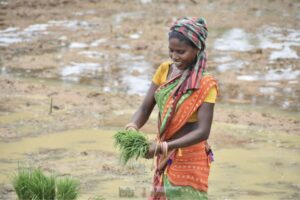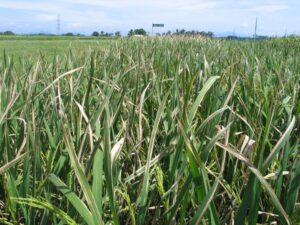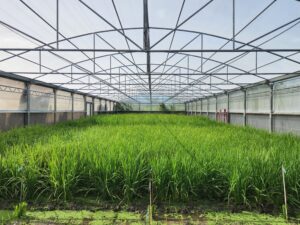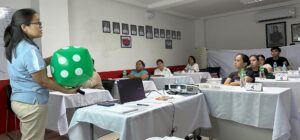
BANGKOK, Thailand, 28 October 2014 – The second Green Revolution in rice has been under way for more than 6 years, reckons Robert Zeigler, director general of the International Rice Research Institute (IRRI). This second Green Revolution, or GR2.0, seeks to benefit the most unfavorable rice-growing areas and leave no farmer behind.
Zeigler addressed around 1,500 attendees from 69 countries at the opening ceremony of the 4th International Rice Congress, or IRC2014, at the Bangkok International Trade & Exhibition Centre (BITEC).
IRC2014 is being held under the patronage of the Royal Government of Thailand, specifically the Ministry of Agriculture and Cooperatives, and is touted as the “Olympics of rice science,” being the largest gathering of rice science and industry held every four years.
In his keynote message, the head of the world’s premier center for rice research reported that “there is already profound impact for several million farmers worldwide who have adopted one of the first technologies of the second Green Revolution—flood-tolerant rice.”
“Many of these farmers belong to the poorest of the poor who, for various reasons, did not benefit fully from the first Green Revolution in rice,” Zeigler pointed out.
Zeigler, citing marginal farmers as an added focus of IRRI’s research, is echoed by Apichart Pongsrihadulchai, Thai vice minister for agriculture and cooperatives, who said that he now feels hopeful again for Thai farmers.
Thailand was the world’s top exporter for a long time, but two years ago, it lost the top spot. The country’s agriculture authorities, however, feel a change in the wind. “Thailand can be the number one exporter again soon,” the minister said, “but it does not mean we’d be happy to be number one, if the farmers are still poor.”
Revolution stirs in the deep puddles
Zeigler told the story of Mr. Asha Ram Pal, a poor farmer from the Indian state of Uttar Pradesh who tills a hectare of land in an area hostile to growing rice.
At 1:10 in the afternoon of 31 July 2008, ignoring the advice of his neighbors, Mr. Pal made the decision not to plow under his severely ravaged and sick-looking rice crop. His field had been submerged for 17 days from two floods.
The rice that Mr. Pal planted, a new variety that had the SUB1 gene for flood-tolerance, recovered to yield 4.5 tons—the global average rice yield per hectare.
“Since then, Sub1 rice varieties have spread like wildfire in eastern India and other regions where flooding is a perennial problem for rice farmers in such marginal environments,” he said.
Early epiphanies
The start of the first Green Revolution in rice, Zeigler thought back, could have been in July 1963 when IRRI’s first breeder, Peter Jennings, found F2 (second-generation) rice plants from a set of 38 crosses involving dwarf rice varieties from Taiwan. Later generations of this selection ultimately resulted in the semi-dwarf IR8—and all succeeding modern rice varieties.
“Forty-five years between the start of GR1.0 and of GR2.0 was a pretty long time,” Zeigler said. “But a lot had to be done. GR2.0 is profoundly more scientifically rich and complex and that is something to really get excited about,” Dr. Zeigler told the IRC2014 delegates.
“GR2.0’s run will be fruitful—and quicker than GR1.0—particularly for farmers in marginal weather-stressed environments,” he predicted.
He cited the very wide array of problems, previously thought to be absolutely insurmountable, that researchers can now find solutions for more rapidly using scientific tools coming out of parallel high-science revolutions in genetics, molecular biology, and plant physiology.
“Over the next 10 to 20 years, during which GR2.0 will phase into GR3.0, we will seize opportunities for sustainable rice production in ways that will stagger our imagination,” he confidently forecasted.
The work never stops
In another bold prediction, he envisions the start of GR3.0 sometime around 2030, when farmers start planting far more robust C4 and nitrogen-fixing rice varieties and consumers begin finding nutritious rice in the marketplace.
Leading the charge of GR2.0 and 3.0 will be a crop of vibrant and intelligent young scientists in league with IRRI through the Global Rice Science Partnership (GRiSP) and spread out across Asia, Africa, and Latin America, “many of whom are attending their first International Rice Congress now,” said Zeigler, himself a plant pathologist who started young working on various crop staples.
At IRC2014, 29 young rice scientists have been chosen to present their research during the science sessions and will be formally recognized during the IRC gala dinner on Thursday evening.
“The future of rice science is at stake. Without new blood in the experiment plots and laboratories, the outlook for GR2.0 would be grim and there wouldn’t even be a GR3.0,” he concluded.









